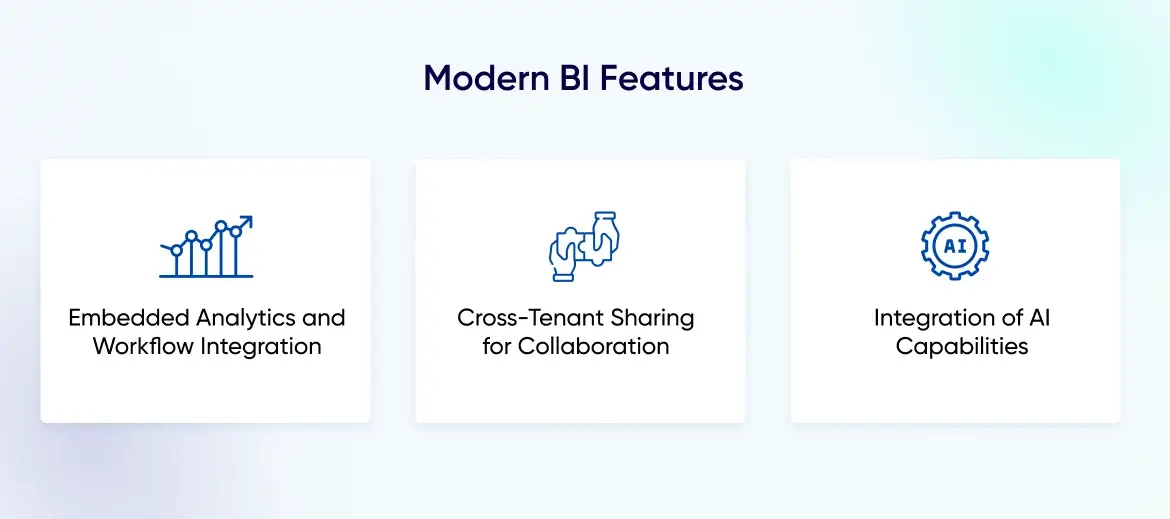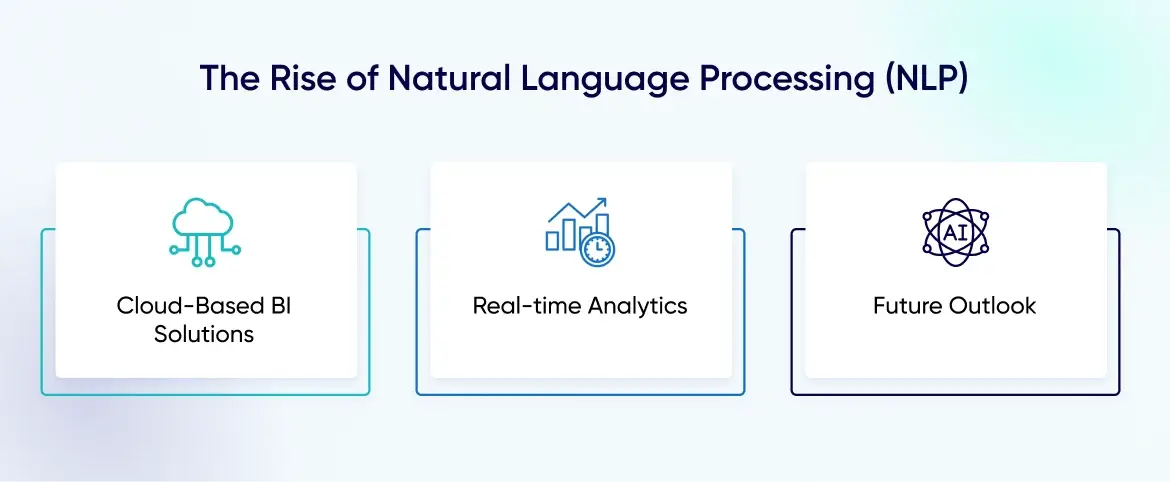The evolution of Business Intelligence (BI) tools is a fascinating journey that mirrors the dynamic shifts in technology and the growing demands of businesses to harness the power of data.
Here’s the Evolution of Business Intelligence presented in a table form:
| Stage | Timeline | Description |
| Reporting | 1960s – 1980s | The focus is on basic reporting capabilities, utilizing static reports to present historical data. |
| Decision Support Systems (DSS) | Late 1970s – 1990s | Introduction of interactive systems allowing users to explore data and make simple decisions. Incorporates features like ad-hoc querying and multidimensional analysis. |
| Online Analytical Processing (OLAP) | 1990s | OLAP technology enables interactive analysis of data from multiple dimensions, facilitating in-depth insights into trends and patterns. OLAP cubes have become popular for organizing and visualizing multidimensional data. |
| Data Warehousing | 1990s | Organizations integrate data from various sources into centralized data warehouses, providing a unified and consistent view of enterprise data. |
| Data Mining and Advanced Analytics | Late 1990s – 2000s | Introduction of data mining and advanced analytics. Statistical methods and machine learning algorithms are employed to discover hidden patterns, correlations, and trends within the data. Predictive analytics becomes crucial for forecasting and decision-making. |
| Self-Service BI | 2010s | User-friendly BI tools empower business users to create their own reports and analyses without heavy reliance on IT. Self-service BI platforms allow independent access and visualization of data. |
| Big Data and Real-time Analytics | Mid-2010s – Present | Rise of big data technologies and real-time analytics. Organizations handle large volumes of diverse data sources, including streaming data. Real-time analytics becomes crucial for decision-making in dynamic business environments. |
| Cloud-Based BI | Present | Cloud-based BI solutions gain popularity for flexibility, scalability, and cost-effectiveness. Cloud platforms enable easy access to BI tools, collaboration, and data storage. |
| AI and Augmented Analytics | Present and Future | Integration of AI and machine learning into BI processes. Augmented analytics leverages AI to automate data preparation, discovery, and insight generation. Natural Language Processing (NLP) and machine learning enhance accessibility and usability of BI tools. |
Impact of Massive Data Volume and Cloud Computing:
In the era of unprecedented data growth, the impact of massive data volume and the integration of cloud computing have reshaped the landscape of Business Intelligence (BI) tools. This section explores the profound influence of Big Data and cloud technologies on the evolution and effectiveness of BI.
1. Definition and Role of Big Data –
The influx of massive datasets often termed Big Data, posed new challenges and opportunities. BI tools adapted to handle the volume, velocity, and variety of data, unlocking deeper insights. For instance, financial institutions leverage Big Data analytics to detect fraud by analyzing large datasets and identifying unusual patterns in transactions.
2. Cloud Computing in BI Operations –
Cloud computing revolutionized BI operations by providing scalable and cost-effective solutions. Cloud-based BI tools allow organizations to access, analyze, and share data seamlessly. An example is e-commerce platforms using cloud-based BI tools to swiftly adapt to fluctuating demand patterns and optimize inventory management, thereby improving operational efficiency.
3. Benefits of Cloud-Based BI Tools –
The advantages of cloud-based BI tools include increased flexibility, real-time collaboration, and reduced infrastructure costs. Examples of such tools include Microsoft Power BI, Tableau, and Looker BI. Companies like Salesforce utilize cloud-based BI for real-time sales analytics, empowering sales teams with instant insights for strategic decision-making. This scalability and flexibility enable businesses to adapt to changing market conditions more effectively.
| Business Intelligence Tool | Introduction |
|---|---|
| Power BI (Microsoft) | Power BI is a cloud-based business analytics service that enables users to visualize and share insights across an organization. With features like interactive dashboards, Power BI connects to a wide range of data sources, allowing users to create compelling reports and visualizations. |
| Tableau (Salesforce) | Tableau is renowned for its powerful data visualization capabilities. It empowers users to explore and understand their data through interactive dashboards. Tableau connects to various data sources, enabling users to create insightful reports and share them with others. |
| Looker (Google Cloud) | Looker is known for its data exploration and business intelligence platform. It provides a centralized platform for data discovery and collaboration. Looker’s data modeling and exploration capabilities facilitate a deeper understanding of business data. |
You can also refer to our article: Choosing the Perfect BI Tool: An In-depth Comparison of Looker BI, Power BI, and Tableau
Modern BI Features:
As businesses continue to grapple with increasing data complexity and diversity, Modern Business Intelligence (BI) tools have evolved to offer a suite of advanced features that go beyond traditional reporting. Here, we explore key features that characterize the modern era of BI, focusing on tools like Power BI, Tableau, and Looker.

1. Embedded Analytics and Workflow Integration –
Modern BI tools, including Power BI, Tableau, and Looker, seamlessly integrate into existing workflows, ensuring that analytics is not a separate endeavor but an intrinsic part of decision-making processes. For instance, marketing teams integrate BI tools into their campaign workflows, allowing them to track real-time performance metrics and optimize strategies on the fly, resulting in more effective marketing campaigns.
2. Cross-Tenant Sharing for Collaboration –
Collaboration is key, and BI tools like Looker facilitate cross-tenant sharing, enabling diverse teams to collaborate and share insights effortlessly. In the finance sector, teams across different departments can collaborate on financial forecasts using BI tools, ensuring a unified and accurate analysis for strategic financial planning. This collaboration enhances overall organizational efficiency and decision-making.
3. Integration of AI Capabilities –
Power BI, Tableau, and Looker have all embraced AI-driven features, such as automated insights, natural language processing, and predictive analytics. These enhancements make BI tools more intuitive and user-friendly. An example is the retail industry using AI-powered BI to analyze customer behavior and predict trends, enhancing personalized marketing efforts and inventory management. This integration of AI enhances the speed and accuracy of data analysis, providing valuable insights for strategic decision-making.
Key Business Intelligence Trends for 2024 and Future Outlook:
As we step into 2024, BI continues to evolve. Key trends include the rise of augmented analytics involving the use of machine learning and AI techniques to enhance data analytics processes. It is imperative to stay abreast of the latest trends for organizations aiming to harness the power of data effectively.
In 2024, the Business Intelligence (BI) industry is witnessing a paradigm shift, driven by technological advancements and changing business dynamics. Let’s delve into the key BI trends shaping the landscape and explore the future outlook for this transformative field.
-
Augmented Analytics –
Augmented analytics is set to redefine how businesses interact with data. Leveraging machine learning and AI algorithms, augmented analytics automates data preparation, insight generation, and natural language processing, enabling users to make data-driven decisions without requiring specialized skills.
-
Embedded BI for Seamless Integration –
Embedding BI directly into operational applications is gaining prominence. This integration ensures that insights are seamlessly woven into the fabric of daily workflows, empowering users to make informed decisions without switching between multiple platforms.
-
Data Democratization –
The democratization of data is an ongoing trend, aiming to make data accessible to a broader audience within organizations. This involves empowering non-technical users to explore and analyze data, fostering a culture of data-driven decision-making across all levels.
-
Focus on Data Governance and Security –
With the increasing volume of data being generated and processed, data governance and security have become paramount. BI solutions are placing a strong emphasis on ensuring data quality, integrity, and compliance with regulations, providing organizations with a solid foundation for their data initiatives.
Advanced-Data Visualization Techniques:
As the demand for actionable insights grows, advanced data visualization techniques are emerging as a key trend. From interactive dashboards to immersive analytics experiences, BI tools are evolving to deliver information in more intuitive and compelling ways.
-
The rise of Natural Language Processing (NLP) –
Natural Language Processing is making BI tools more accessible to a wider audience. Users can now interact with data using natural language queries, making the analysis process more user-friendly and bridging the gap between data experts and business users.

-
Cloud-Based BI Solutions –
Cloud-based BI solutions continue to gain traction, offering scalability, flexibility, and cost-effectiveness. The ability to access and analyze data from anywhere, coupled with the seamless integration of cloud services, makes cloud-based BI an integral part of modern business strategies.
-
Real-time Analytics –
In today’s fast-paced business environment, the need for real-time analytics is more pronounced than ever. BI tools are evolving to provide instantaneous insights, enabling organizations to respond quickly to changing market conditions and emerging opportunities.
-
Future Outlook –
The future of BI holds exciting possibilities, with ongoing advancements in AI, machine learning, and data management. As organizations continue to recognize the strategic value of data, BI will play a pivotal role in shaping business strategies, fostering innovation, and driving sustainable growth.
Embracing these trends will not only empower businesses today but also position them for success in the dynamic landscape of tomorrow’s business intelligence.
Help users by automating insights, data preparation, and sharing actionable insights. The increase in the adoption of cloud-based BI solutions and BI tools like Looker continues to grow. These platforms offer scalability, flexibility, and cost-effectiveness for organizations to store, analyze and visualize large volumes of data.
Closing Thoughts on the Transformative Power of BI Tools in Decision-Making:
In conclusion, the journey of BI tools from their historical roots to the present day exemplifies their transformative power. These tools have become indispensable for organizations seeking to navigate the complexities of the business landscape. As we look to the future, the integration of BI with emerging technologies promises even more sophisticated and impactful insights, revolutionizing decision-making processes across industries. The era of data-driven decision-making is here, and BI tools are at the forefront, guiding businesses towards success in the digital age.


